如何用策略模式,优化你代码里的的if-else?
本次就来具体聊聊策略模式它是如何做到行为解耦
大纲
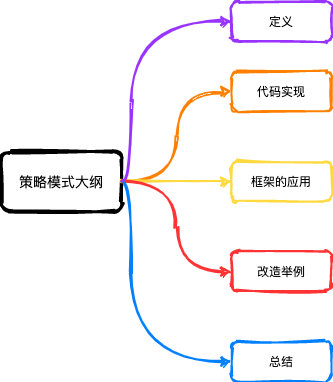 定义
定义
什么是策略模式?它的原理实现是怎么样的?
定义一系列算法,封装每个算法,并使他们可以互换,不同的策略可以让算法独立于使用它们的客户而变化。 以上定义来自设计模式之美
感觉有点抽象?那就来看一张结构图吧
Context(环境):运行特定的策略类。
这么看结构其实还是不复杂的,而且跟状态模式类似。
那么这个代码怎么实现?
举个例子,汽车大家肯定都不陌生,愿大家早日完成汽车梦,汽车的不同档(concreteStrategy)就好比不同的策略,驾驶者选择几档则汽车按几档的速度前进,整个选择权在驾驶者(context)手中。
public interface GearStrategy {
// 定义策略执行方法
void algorithm(String param);
}
首先还是先定义抽象策略
这里是用接口的形式,还有一种方式可以用抽象方法abstract来写也是一样的。具体就看大家自己选择了。
public abstract class GearStrategyAbstract {
// 定义策略执行方法
abstract void algorithm(String param);
}
public class GearStrategyOne implements GearStrategy {
@Override
public void algorithm(String param) {
System.out.println("当前档位" + param);
}
}
其次定义具体档位策略,实现algorithm方法。
public class Context {
// 缓存所有的策略,当前是无状态的,可以共享策略类对象
private static final Map<String, GearStrategy> strategies = new HashMap<>();
// 第一种写法
static {
strategies.put("one", new GearStrategyOne());
}
public static GearStrategy getStrategy(String type) {
if (type == null || type.isEmpty()) {
throw new IllegalArgumentException("type should not be empty.");
}
return strategies.get(type);
}
// 第二种写法
public static GearStrategy getStrategySecond(String type) {
if (type == null || type.isEmpty()) {
throw new IllegalArgumentException("type should not be empty.");
}
if (type.equals("one")) {
return new GearStrategyOne();
}
return null;
}
public static void main(String[] args) {
// 测试结果
GearStrategy strategyOne = Context.getStrategy("one");
strategyOne.algorithm("1档");
// 结果:当前档位1档
GearStrategy strategyTwo = Context.getStrategySecond("one");
strategyTwo.algorithm("1档");
// 结果:当前档位1档
}
}
最后就是实现运行时环境(Context),你可以定义成StrategyFactory,但都是一个意思。
在main方法里面的测试demo,可以看到通过不同的type类型,可以实现不同的策略,这就是策略模式主要思想。
在Context里面定义了两种写法:
第一种是维护了一个strategies的Map容器。用这种方式就需要判断每种策略是否可以共享使用,它只是作为算法的实现。
第二种是直接通过有状态的类,每次根据类型new一个新的策略类对象。这个就需要根据实际业务场景去做的判断。
框架的应用
策略模式在框架中也在一个很常见的地方体现出来了,而且大家肯定都有使用过。
那就是JDK中的线程池ThreadPoolExecutor
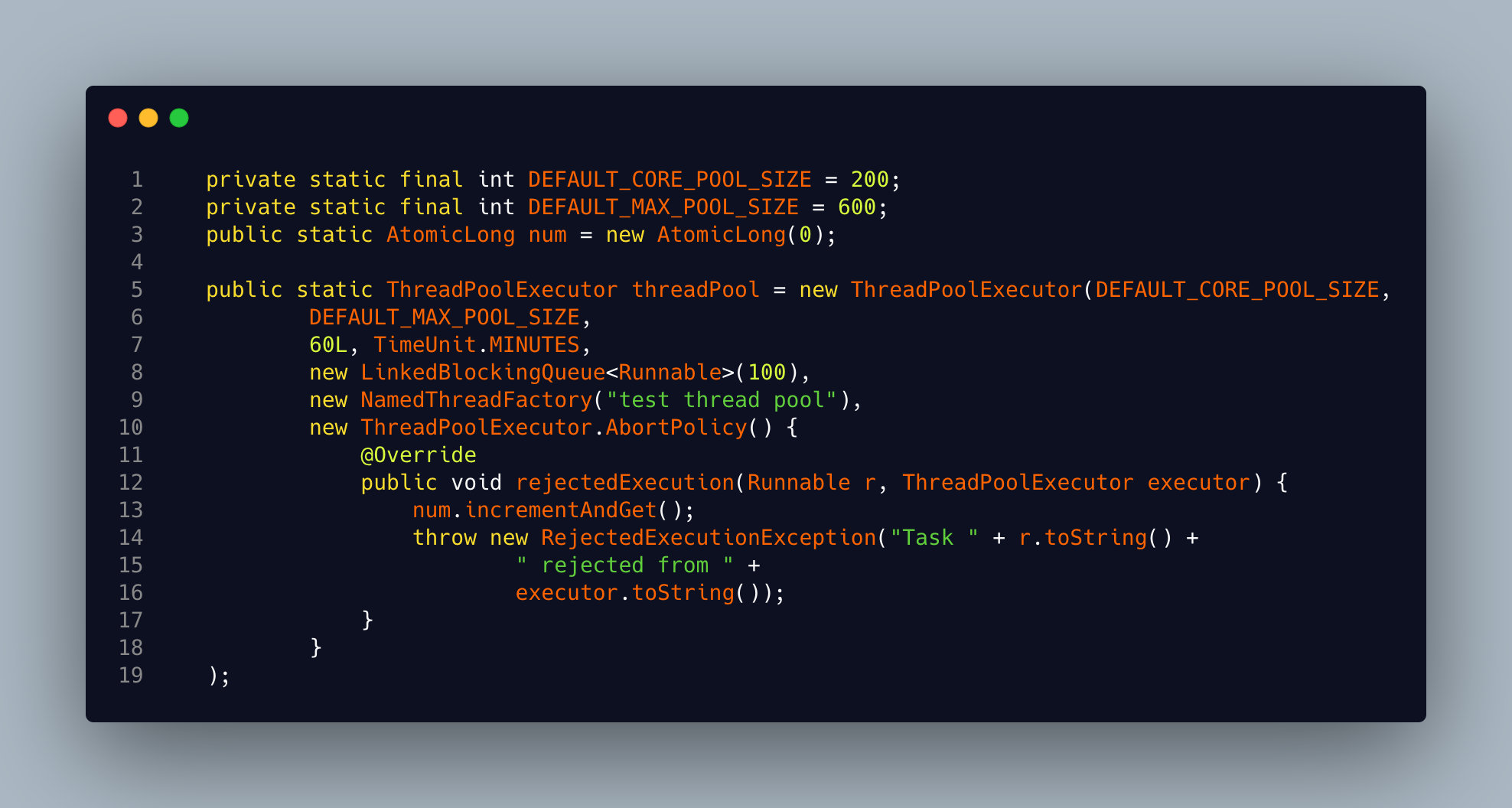 首先都是类似于这样定义一个线程池,里面实现线程池的异常策略。
首先都是类似于这样定义一个线程池,里面实现线程池的异常策略。
这个线程池的异常策略就是用的策略模式的思想。
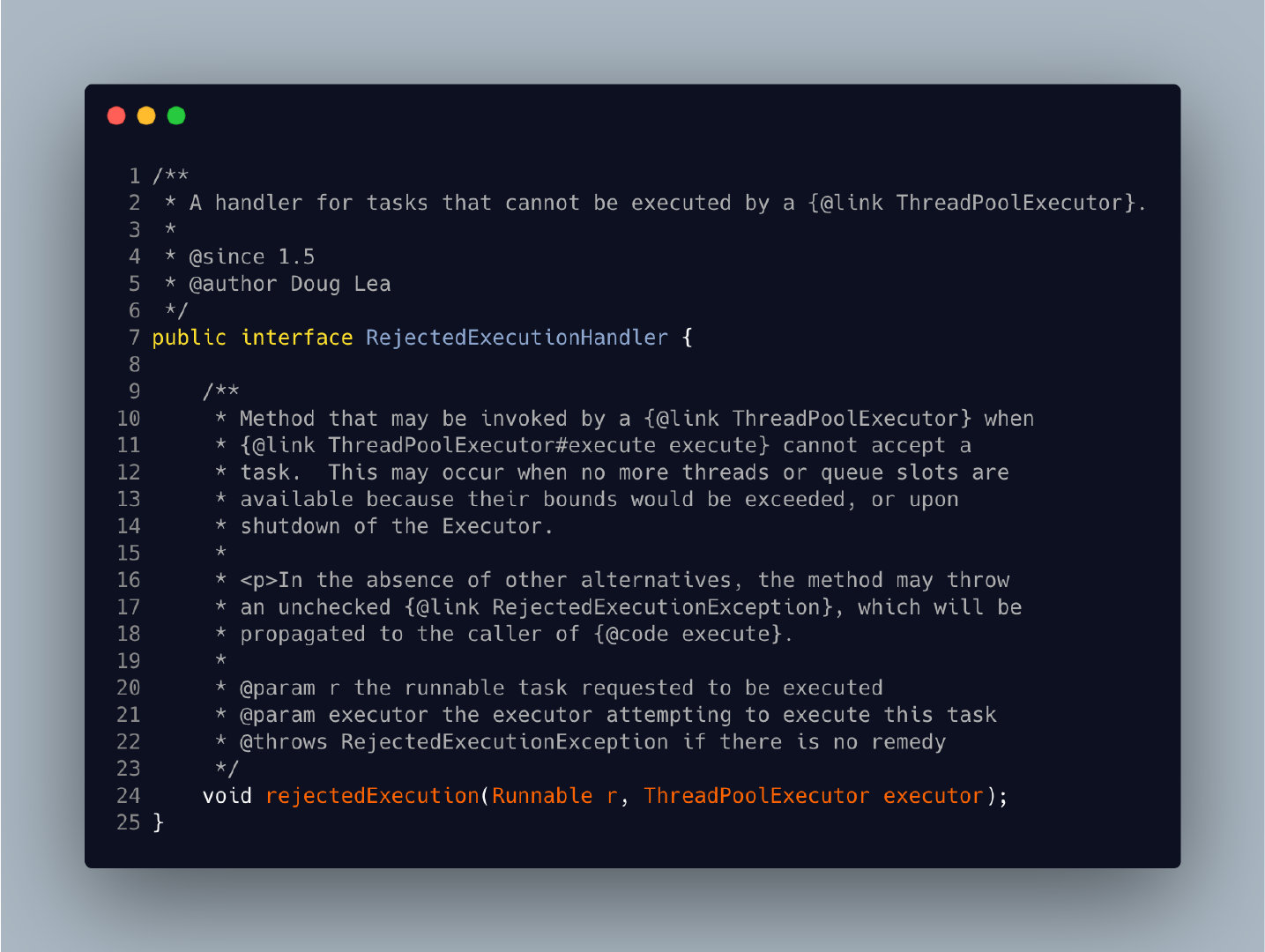 在源码中有RejectedExecutionHandler这个抽象异常策略接口,同时它也有四种拒绝策略。关系图如下:
在源码中有RejectedExecutionHandler这个抽象异常策略接口,同时它也有四种拒绝策略。关系图如下:
在真实的业务场景中策略模式也还是应用很多的。
在社交电商中分享商品是一个很重要的环节,假设现在要我们实现一个分享图片功能,比如当前有 单商品、多商品、下单、会场、邀请、小程序链接等等多种分享场景。
public class SingleItemShare {
// 单商品
public void algorithm(String param) {
System.out.println("当前分享图片是" + param);
}
}
public class MultiItemShare {
// 多商品
public void algorithm(String param) {
System.out.println("当前分享图片是" + param);
}
}
public class OrderItemShare {
// 下单
public void algorithm(String param) {
System.out.println("当前分享图片是" + param);
}
}
public class ShareFactory {
public static void main(String[] args) throws Exception {
Integer shareType = 1;
// 测试业务逻辑
if (shareType.equals(ShareType.SINGLE.getCode())) {
SingleItemShare singleItemShare = new SingleItemShare();
singleItemShare.algorithm("单商品");
} else if (shareType.equals(ShareType.MULTI.getCode())) {
MultiItemShare multiItemShare = new MultiItemShare();
multiItemShare.algorithm("多商品");
} else if (shareType.equals(ShareType.ORDER.getCode())) {
OrderItemShare orderItemShare = new OrderItemShare();
orderItemShare.algorithm("下单");
} else {
throw new Exception("未知分享类型");
}
// .....省略更多分享场景
}
enum ShareType {
SINGLE(1, "单商品"),
MULTI(2, "多商品"),
ORDER(3, "下单");
/**
* 场景对应的编码
*/
private Integer code;
/**
* 业务场景描述
*/
private String desc;
ShareType(Integer code, String desc) {
this.code = code;
this.desc = desc;
}
public Integer getCode() {
return code;
}
// 省略 get set 方法
}
}
这里大家可以看到每新加一种分享类型,就需要加一次if else 判断,当如果有十几种场景的时候那代码整体就会非常的长,看起来给人的感觉也不是很舒服。
接下来就看看如何用策略模式进行重构:
public interface ShareStrategy {
// 定义分享策略执行方法
void shareAlgorithm(String param);
}
public class OrderItemShare implements ShareStrategy {
@Override
public void shareAlgorithm(String param) {
System.out.println("当前分享图片是" + param);
}
}
// 省略 MultiItemShare以及SingleItemShare策略
// 分享工厂
public class ShareFactory {
// 定义策略枚举
enum ShareType {
SINGLE("single", "单商品"),
MULTI("multi", "多商品"),
ORDER("order", "下单");
// 场景对应的编码
private String code;
// 业务场景描述
private String desc;
ShareType(String code, String desc) {
this.code = code;
this.desc = desc;
}
public String getCode() {
return code;
}
// 省略 get set 方法
}
// 定义策略map缓存
private static final Map<String, ShareStrategy> shareStrategies = new HashMap<>();
static {
shareStrategies.put("order", new OrderItemShare());
shareStrategies.put("single", new SingleItemShare());
shareStrategies.put("multi", new MultiItemShare());
}
// 获取指定策略
public static ShareStrategy getShareStrategy(String type) {
if (type == null || type.isEmpty()) {
throw new IllegalArgumentException("type should not be empty.");
}
return shareStrategies.get(type);
}
public static void main(String[] args) {
// 测试demo
String shareType = "order";
ShareStrategy shareStrategy = ShareFactory.getShareStrategy(shareType);
shareStrategy.shareAlgorithm("order");
// 输出结果:当前分享图片是order
}
}
这里策略模式就已经改造完了。在client请求端,根本看不到那么多的if else判断,只需要传入对应的策略方式即可,这里我们维护了一个策略缓存map,在直接调用的ShareFactory获取策略的时候就直接是从换种获取策略类对象。
这就已经达到了行为解偶的思想。同时也避免了长串的if else 判断。
优点:
算法策略可以自由实现切换
扩展性好,加一个策略,只需要增加一个类
缺点:
策略类数量多
需要维护一个策略枚举,让别人知道你当前具有哪些策略
总结
以上就讲完了策略模式,整体看上去其实还是比较简单的,还是那句话学习设计模式我们还是要学习每种设计模式的思想,任何一种设计模式存在即合理。当然也不要因为设计模式而设计代码,那样反而得不偿失。
大纲
 定义
定义什么是策略模式?它的原理实现是怎么样的?
定义一系列算法,封装每个算法,并使他们可以互换,不同的策略可以让算法独立于使用它们的客户而变化。 以上定义来自设计模式之美
感觉有点抽象?那就来看一张结构图吧

Strategy(抽象策略):抽象策略类,并且定义策略执行入口
ConcreteStrategy(具体策略):实现抽象策略,实现algorithm方法Context(环境):运行特定的策略类。
这么看结构其实还是不复杂的,而且跟状态模式类似。
那么这个代码怎么实现?
举个例子,汽车大家肯定都不陌生,愿大家早日完成汽车梦,汽车的不同档(concreteStrategy)就好比不同的策略,驾驶者选择几档则汽车按几档的速度前进,整个选择权在驾驶者(context)手中。
public interface GearStrategy {
// 定义策略执行方法
void algorithm(String param);
}
首先还是先定义抽象策略
这里是用接口的形式,还有一种方式可以用抽象方法abstract来写也是一样的。具体就看大家自己选择了。
public abstract class GearStrategyAbstract {
// 定义策略执行方法
abstract void algorithm(String param);
}
public class GearStrategyOne implements GearStrategy {
@Override
public void algorithm(String param) {
System.out.println("当前档位" + param);
}
}
其次定义具体档位策略,实现algorithm方法。
public class Context {
// 缓存所有的策略,当前是无状态的,可以共享策略类对象
private static final Map<String, GearStrategy> strategies = new HashMap<>();
// 第一种写法
static {
strategies.put("one", new GearStrategyOne());
}
public static GearStrategy getStrategy(String type) {
if (type == null || type.isEmpty()) {
throw new IllegalArgumentException("type should not be empty.");
}
return strategies.get(type);
}
// 第二种写法
public static GearStrategy getStrategySecond(String type) {
if (type == null || type.isEmpty()) {
throw new IllegalArgumentException("type should not be empty.");
}
if (type.equals("one")) {
return new GearStrategyOne();
}
return null;
}
public static void main(String[] args) {
// 测试结果
GearStrategy strategyOne = Context.getStrategy("one");
strategyOne.algorithm("1档");
// 结果:当前档位1档
GearStrategy strategyTwo = Context.getStrategySecond("one");
strategyTwo.algorithm("1档");
// 结果:当前档位1档
}
}
最后就是实现运行时环境(Context),你可以定义成StrategyFactory,但都是一个意思。
在main方法里面的测试demo,可以看到通过不同的type类型,可以实现不同的策略,这就是策略模式主要思想。
在Context里面定义了两种写法:
第一种是维护了一个strategies的Map容器。用这种方式就需要判断每种策略是否可以共享使用,它只是作为算法的实现。
第二种是直接通过有状态的类,每次根据类型new一个新的策略类对象。这个就需要根据实际业务场景去做的判断。
框架的应用
策略模式在框架中也在一个很常见的地方体现出来了,而且大家肯定都有使用过。
那就是JDK中的线程池ThreadPoolExecutor
 首先都是类似于这样定义一个线程池,里面实现线程池的异常策略。
首先都是类似于这样定义一个线程池,里面实现线程池的异常策略。这个线程池的异常策略就是用的策略模式的思想。
 在源码中有RejectedExecutionHandler这个抽象异常策略接口,同时它也有四种拒绝策略。关系图如下:
在源码中有RejectedExecutionHandler这个抽象异常策略接口,同时它也有四种拒绝策略。关系图如下: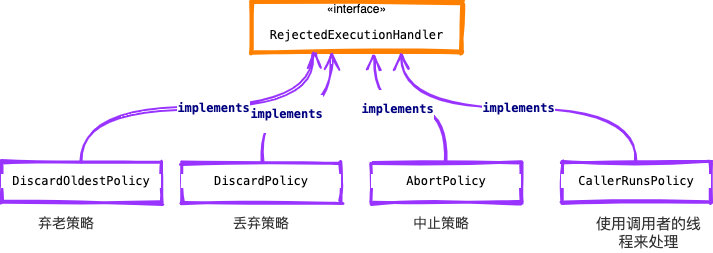
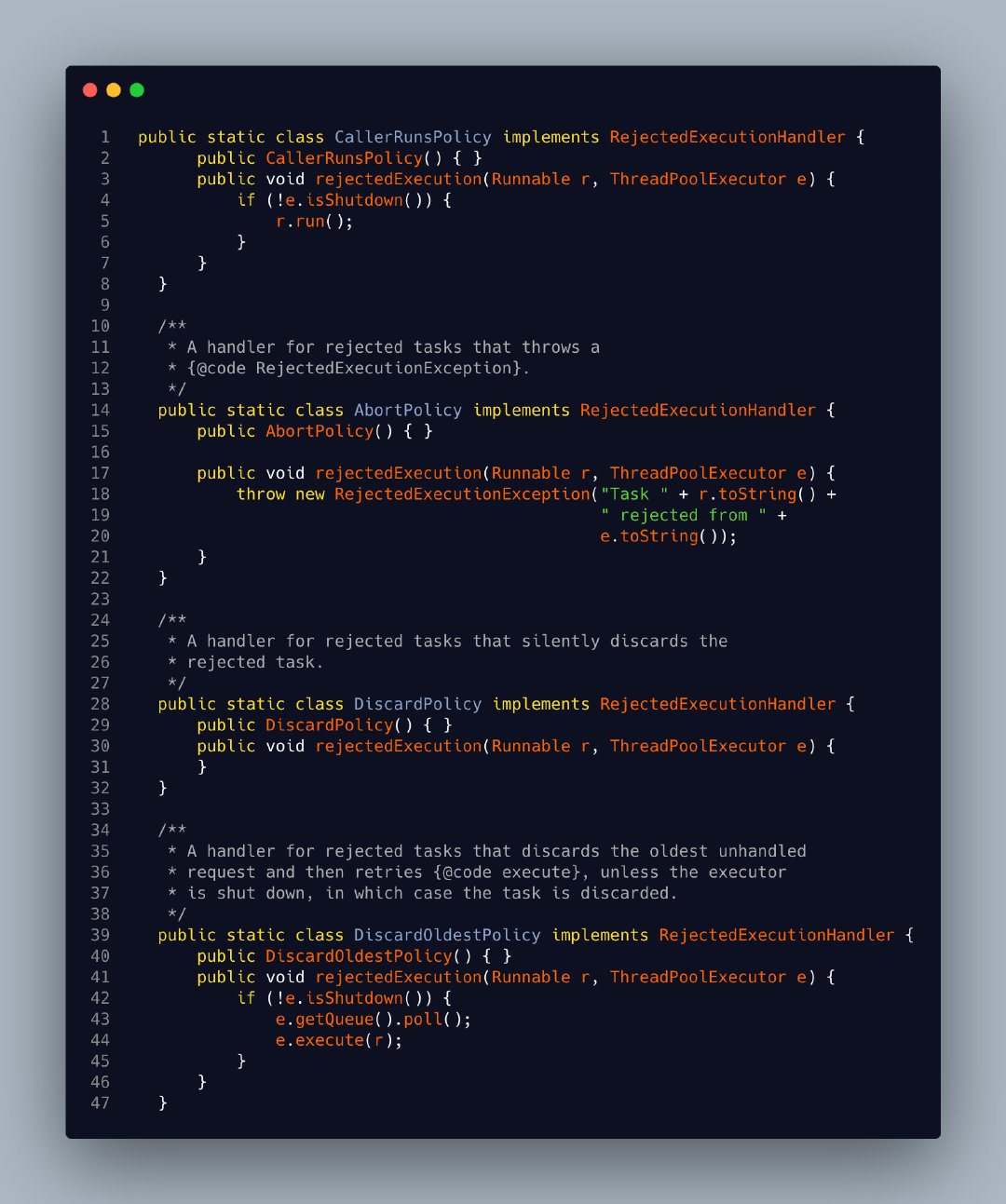
这就是在框架中的体现了,根据自己的业务场景,合理的选择线程池的异常策略。
在真实的业务场景中策略模式也还是应用很多的。
在社交电商中分享商品是一个很重要的环节,假设现在要我们实现一个分享图片功能,比如当前有 单商品、多商品、下单、会场、邀请、小程序链接等等多种分享场景。
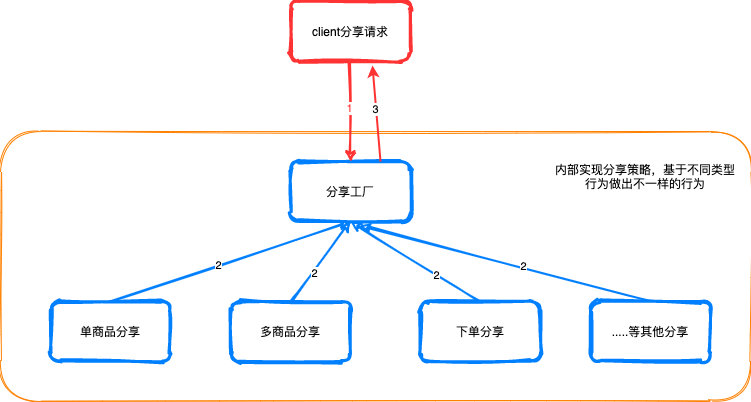
针对上线这个流程图先用if else语句做一个普通业务代码判断,就像下面的这中方式:
public class SingleItemShare {
// 单商品
public void algorithm(String param) {
System.out.println("当前分享图片是" + param);
}
}
public class MultiItemShare {
// 多商品
public void algorithm(String param) {
System.out.println("当前分享图片是" + param);
}
}
public class OrderItemShare {
// 下单
public void algorithm(String param) {
System.out.println("当前分享图片是" + param);
}
}
public class ShareFactory {
public static void main(String[] args) throws Exception {
Integer shareType = 1;
// 测试业务逻辑
if (shareType.equals(ShareType.SINGLE.getCode())) {
SingleItemShare singleItemShare = new SingleItemShare();
singleItemShare.algorithm("单商品");
} else if (shareType.equals(ShareType.MULTI.getCode())) {
MultiItemShare multiItemShare = new MultiItemShare();
multiItemShare.algorithm("多商品");
} else if (shareType.equals(ShareType.ORDER.getCode())) {
OrderItemShare orderItemShare = new OrderItemShare();
orderItemShare.algorithm("下单");
} else {
throw new Exception("未知分享类型");
}
// .....省略更多分享场景
}
enum ShareType {
SINGLE(1, "单商品"),
MULTI(2, "多商品"),
ORDER(3, "下单");
/**
* 场景对应的编码
*/
private Integer code;
/**
* 业务场景描述
*/
private String desc;
ShareType(Integer code, String desc) {
this.code = code;
this.desc = desc;
}
public Integer getCode() {
return code;
}
// 省略 get set 方法
}
}
这里大家可以看到每新加一种分享类型,就需要加一次if else 判断,当如果有十几种场景的时候那代码整体就会非常的长,看起来给人的感觉也不是很舒服。
接下来就看看如何用策略模式进行重构:
public interface ShareStrategy {
// 定义分享策略执行方法
void shareAlgorithm(String param);
}
public class OrderItemShare implements ShareStrategy {
@Override
public void shareAlgorithm(String param) {
System.out.println("当前分享图片是" + param);
}
}
// 省略 MultiItemShare以及SingleItemShare策略
// 分享工厂
public class ShareFactory {
// 定义策略枚举
enum ShareType {
SINGLE("single", "单商品"),
MULTI("multi", "多商品"),
ORDER("order", "下单");
// 场景对应的编码
private String code;
// 业务场景描述
private String desc;
ShareType(String code, String desc) {
this.code = code;
this.desc = desc;
}
public String getCode() {
return code;
}
// 省略 get set 方法
}
// 定义策略map缓存
private static final Map<String, ShareStrategy> shareStrategies = new HashMap<>();
static {
shareStrategies.put("order", new OrderItemShare());
shareStrategies.put("single", new SingleItemShare());
shareStrategies.put("multi", new MultiItemShare());
}
// 获取指定策略
public static ShareStrategy getShareStrategy(String type) {
if (type == null || type.isEmpty()) {
throw new IllegalArgumentException("type should not be empty.");
}
return shareStrategies.get(type);
}
public static void main(String[] args) {
// 测试demo
String shareType = "order";
ShareStrategy shareStrategy = ShareFactory.getShareStrategy(shareType);
shareStrategy.shareAlgorithm("order");
// 输出结果:当前分享图片是order
}
}
这里策略模式就已经改造完了。在client请求端,根本看不到那么多的if else判断,只需要传入对应的策略方式即可,这里我们维护了一个策略缓存map,在直接调用的ShareFactory获取策略的时候就直接是从换种获取策略类对象。
这就已经达到了行为解偶的思想。同时也避免了长串的if else 判断。
优点:
算法策略可以自由实现切换
扩展性好,加一个策略,只需要增加一个类
缺点:
策略类数量多
需要维护一个策略枚举,让别人知道你当前具有哪些策略
总结
以上就讲完了策略模式,整体看上去其实还是比较简单的,还是那句话学习设计模式我们还是要学习每种设计模式的思想,任何一种设计模式存在即合理。当然也不要因为设计模式而设计代码,那样反而得不偿失。
|
- 上一条: 为什么 HTTP/3 基于UDP,可靠么? 2021-07-22
- 下一条: 靠!我被项目经理和同事嘲笑了,因为不会远程debug调试... 2021-07-25
相关文章
- JavaScript代码片段学设计模式 2021-08-09
- 如何优雅的在业务中使用设计模式(代码如诗) 2021-08-24
- 用100行代码提升10倍的性能 2021-07-05
- 让你搞清楚疑问:你们服务最大的并发量是多少? 2021-07-05
- 如何正确跟踪广告转化数据,优化广告投放效果? 2021-08-11
热度排行










